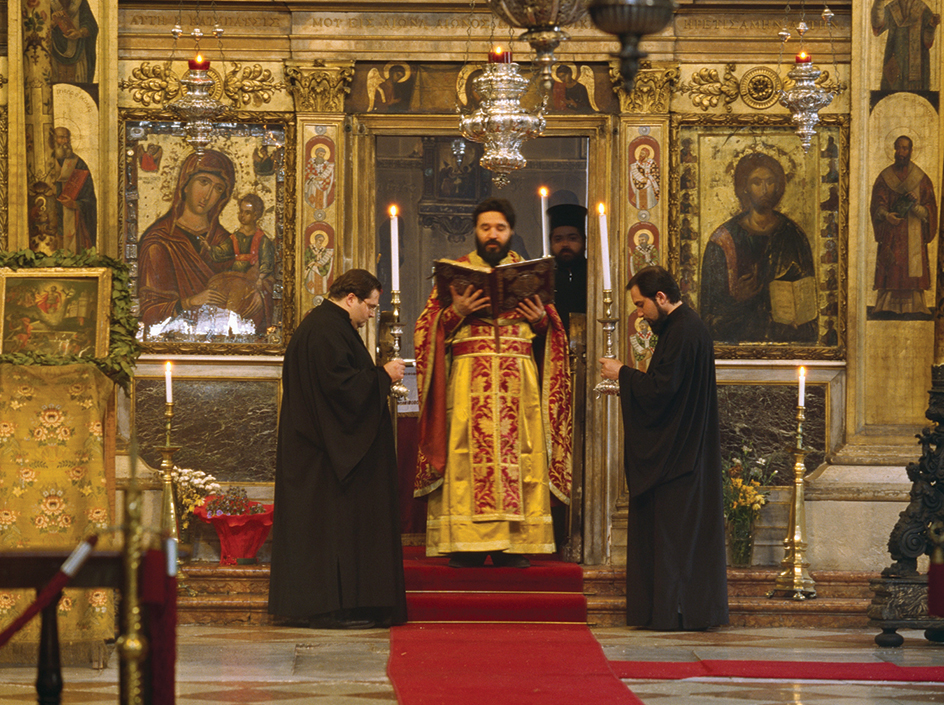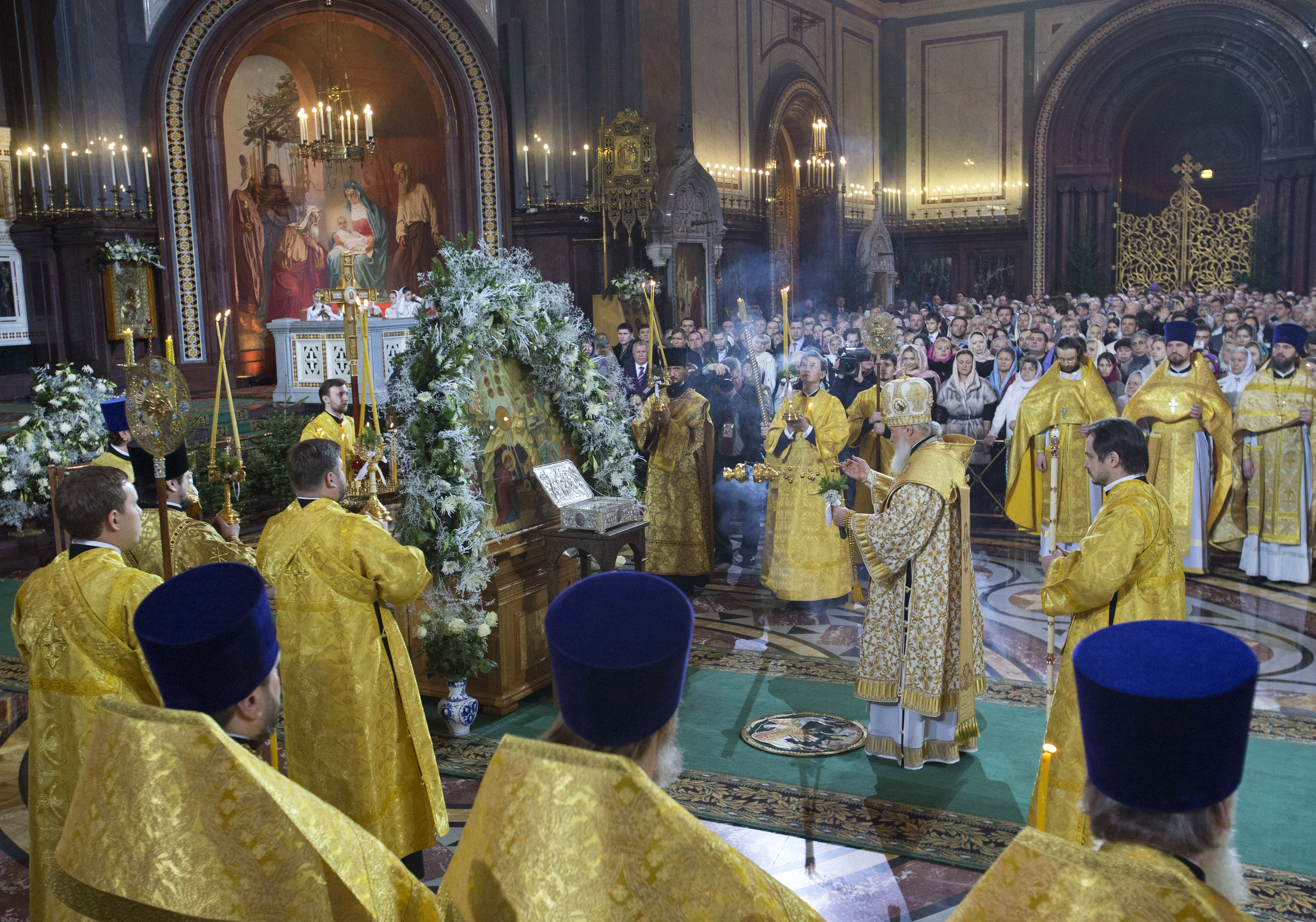Eastern Orthodox Churches are the major Christian churches in Greece, Russia, eastern Europe, and the Middle East. As a federation of churches, they are united by common beliefs and traditions. Individually, they are usually called by their national names, such as the Orthodox Church of Greece or the Russian Orthodox Church. About 275 million people belong to the Eastern Orthodox Churches.

Eastern Orthodox beliefs are based on the Bible and on holy tradition (doctrines worked out mostly during early centuries of Christianity). The decrees of church councils and the writings of early church leaders reflect the authority of church beliefs.
History.
For the first 300 years following Jesus Christ, Christianity struggled for survival in the pagan Roman Empire. Today’s distinction between the Eastern Orthodox and Western (Roman Catholic and Protestant) churches did not exist.
A turning point in church history came in 313 when Roman Emperor Constantine the Great granted Christians freedom to practice their religion. He convened the First Ecumenical Council, also called the first Nicene Council, in Nicaea (now Iznik, Turkey) in 325. This was the first of seven ecumenical councils held between 325 and 787. These councils established church organization and doctrine (see Nicene Councils ). In 330, Constantine established a new imperial capital, which he named in his honor, Constantinople (now Istanbul, Turkey). The city became the center of eastern Christendom.
The year 1054 is generally considered the date of the schism (split) between the Eastern and Western churches. The two churches had been drifting apart for hundreds of years before the final schism. Many political, cultural, and geographical factors contributed to the final split. Two religious issues are generally considered the chief causes of the break. One issue concerned a phrase called the filioque that the Western church added to the Nicene-Constantinopolitan Creed. Another issue was the Roman papal claims to authority over the entire church. Both issues led to a historic dispute in the 800’s between Patriarch Photius of Constantinople and Pope Nicholas I (see Photius ). Disputes continued until, in 1054, delegates of Pope Leo IX issued an anathema (solemn curse of excommunication) against the patriarch of Constantinople. The patriarch then summoned a council that excommunicated the papal delegates.
In 1204, Western Christians on the Fourth Crusade increased the bitterness between Eastern and Western churches when they sacked Constantinople on their way to the Holy Land (Palestine). In 1453, the Ottoman Empire captured the city. The conquerors, who were Muslims, ruled most Orthodox Christians until the 1800’s. Only in Russia, then under the rule of the czars, did the Orthodox church remain free of Muslim control. Under the Muslims, the patriarch of Constantinople was considered the senior bishop of all Orthodox believers. Muslim power declined in the 1800’s, and several Orthodox churches gained self-government as subject peoples won their independence.
Ecumenical Patriarch Athenagoras I held a historic meeting with Pope Paul VI in 1964 in Jerusalem. The meeting was the first between a patriarch of Constantinople and a pope since 1439. In 1965, the two religious leaders lifted the mutual anathemas of 1054. In 2016, Pope Francis and Patriarch Kirill of the Russian Orthodox Church met in Cuba. It was the first meeting between a pope and a Russian Orthodox patriarch since the schism of 1054.
In 2018, the Russian Orthodox Church broke off relations with the Ecumenical Patriarchate of Constantinople over the patriarchate’s decision to make the Orthodox Church of Ukraine fully self-governing. In 1686, the Russian church had been given authority over the Ukrainian Church.

Organization.
The Eastern Orthodox Churches consist of a number of fully and partially self-governing churches. Four of the fully self-governing churches hold places of special honor for historical reasons. They are, in order of seniority, the churches of Constantinople (in Turkey), Alexandria (in Egypt), Antioch (Damascus, Syria), and Jerusalem. Other fully self-governing churches include those of Albania, Bulgaria, Cyprus, the Czech Republic and Slovakia, Georgia, Greece, Poland, Romania, Russia, Serbia, and Ukraine. The leader of the Church of Constantinople, called the ecumenical patriarch, holds a place of honor among Eastern Orthodox clergy as “first among equals.”
Eastern Orthodox Churches in Canada, Finland and other western European countries, central Africa, Japan, and Sinai (Egypt), are not fully self-governing. They were established by missionaries and settlers from Orthodox churches in other countries and continue to be supervised by their mother churches. Nearly all people in Bulgaria, Cyprus, Greece, Romania, and Serbia belong to an Eastern Orthodox church. The church cooperates closely with the government in many of these countries.
Clergy.
There are three major orders of Orthodox clergy–bishops, priests, and deacons. There are also two chief minor orders–subdeacons and readers. The priesthood includes married and monastic clergy. Most married priests head parishes. Monastic clergy usually live in monasteries. Parochial clergy can marry only before ordination. Once ordained, priests and deacons cannot marry. Bishops must be unmarried.
Deacons, subdeacons, and readers assist the priest during religious services. The spiritual life and administration are governed by the principle of shared responsibility between the clergy and laity (nonclergy). The laity often take part in the administration of their church and in the election of their clergy.
Doctrines.
Eastern Orthodox Churches teach that their church is faithful to the teachings of the apostles and free from errors in matters of doctrine. But they do not believe that any one person in the church is infallible. The Bible and holy tradition are the most important sources of Eastern Orthodox teachings. Daily church services are based on the Bible, especially on the Psalms. The services also include many hymns and prayers that reflect the Biblical teachings.
The Nicene-Constantinopolitan Creed expresses the beliefs of Eastern Orthodoxy. The creed probably dates from the First Council of Constantinople in A.D. 381. It is the only creed used in church services.
Eastern Orthodox Christians disagree with Roman Catholics and other Western Christians over the Nicene Creed and the doctrine of the Holy Trinity implied in the filioque addition. Orthodox Christians use the original text of the creed, which states that the Holy Spirit proceeds from the Father. They base their belief on a passage in the Gospel of John (John 15: 26). Roman Catholics and other Western Christians use a later form of text, which states that the Holy Spirit proceeds from the Father and from the Son. This additional phrase is the filioque. The filioque and the papal claims to primacy and infallibility are the major doctrinal disagreements between the Eastern Orthodox Churches and the Roman Catholic Church.
Services
in the Orthodox churches consist of the Divine Liturgy, the Divine Office, and Occasional Offices. The Divine Liturgy is the celebration of the Eucharist. The Divine Office consists of prayers and readings called Matins and Vespers and several lesser offices. Occasional Offices include services for baptisms, marriages, and funerals. All services are sung or chanted, usually in the language of the congregation.


The Eucharist is celebrated according to one of four rites. The two most common are the Liturgy of St. John Chrysostom and the Liturgy of St. Basil. The clergy and the congregation perform the Eucharist together. The Eucharist consists of the Liturgy of the Word and the Liturgy of the Eucharist. The Liturgy of the Word includes the singing of psalms, the reading of Scriptures, and a sermon. The Liturgy of the Eucharist includes the Eucharistic prayer, called the anaphora, and the distribution of Holy Communion.
Church buildings.
Orthodox churches are richly decorated with religious art. Icons (holy images) form an essential part of Orthodox worship. They stimulate the faith and piety of the worshipers. See Icon .
In each church, an altar stands in the center of the sanctuary. A solid screen or partition, called an iconostasis, divides the sanctuary from the rest of the church. The congregation looks into the sanctuary through doorways in the iconostasis.
Sacraments.
Eastern Orthodox Churches have seven major sacraments and several minor ones.
The Eucharist,
a sacramental remembrance of the death and resurrection of Christ and his victory over death, is a mystical sharing in the life and being of Christ by all believers. In the Eucharist, the faithful receive bread and wine that has been transformed into the body and blood of Christ by the Holy Spirit.
Baptism
is a sacrament that admits people into the church. A priest immerses the candidate being baptized into the water three times, saying “The servant of God is baptized in the name of the Father and of the Son and of the Holy Spirit.” The Eastern Orthodox Churches practice infant baptism.
Chrismation
is administered immediately after baptism. It is understood as the bestowal of the Holy Spirit, granting the newly baptized person full membership in the church and the right to participate in the Eucharist.
Confession
(or Penance) is a sacrament in which a person confesses sins to God in the presence of a priest. The priest forgives the sins in the name of God and offers the person spiritual advice.
Marriage
joins husband and wife and forms a family. Eastern Orthodox Churches teach that one marriage is the ideal. However, they tolerate divorce and allow divorced persons to remarry. But the Eastern Orthodox Churches believe the first marriage is the greatest in the eyes of God. Most Orthodox churches permit only three marriages. When a divorced person remarries, several of the joyful ceremonies of the original marriage sacrament are replaced by prayers asking forgiveness.
Holy orders
admits men to the major and minor orders of the clergy. Only a bishop can ordain. The congregation gives its consent to those taking holy orders by saying axios, meaning he is worthy, during the service.
Anointing of the sick,
also called holy unction, is a sacrament in which a priest anoints a sick person and prays for forgiveness of the person’s sins and for his or her recovery.
